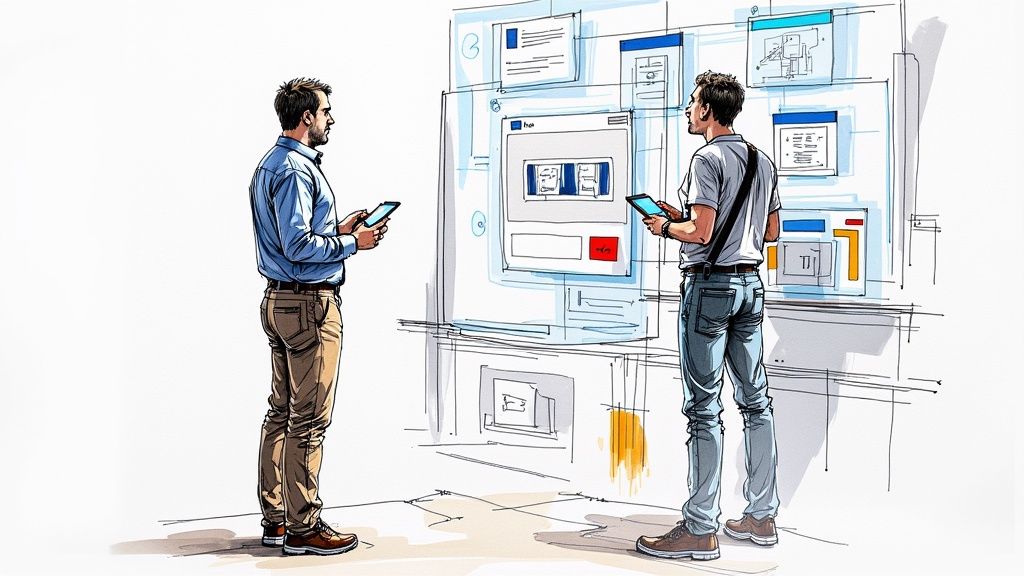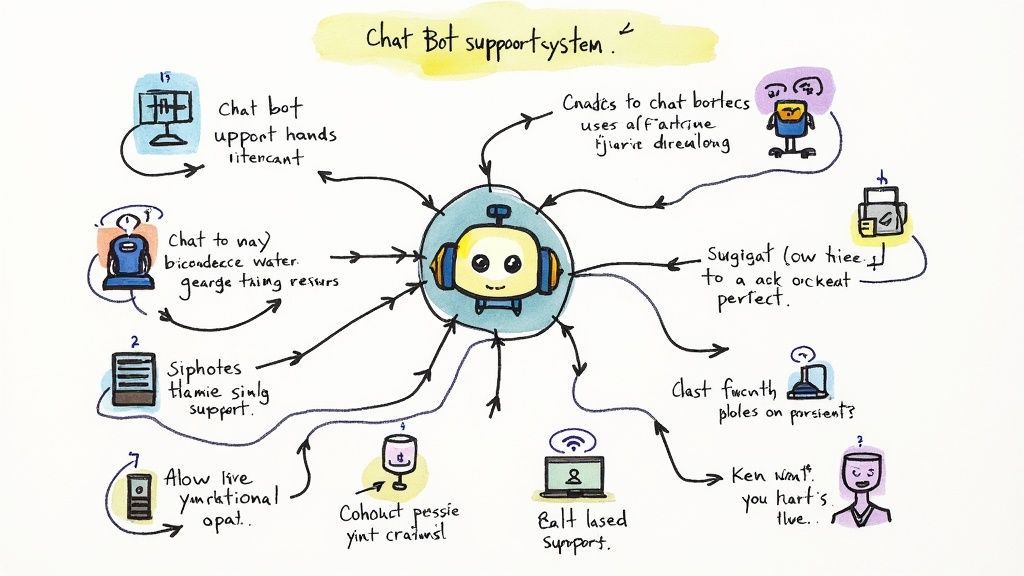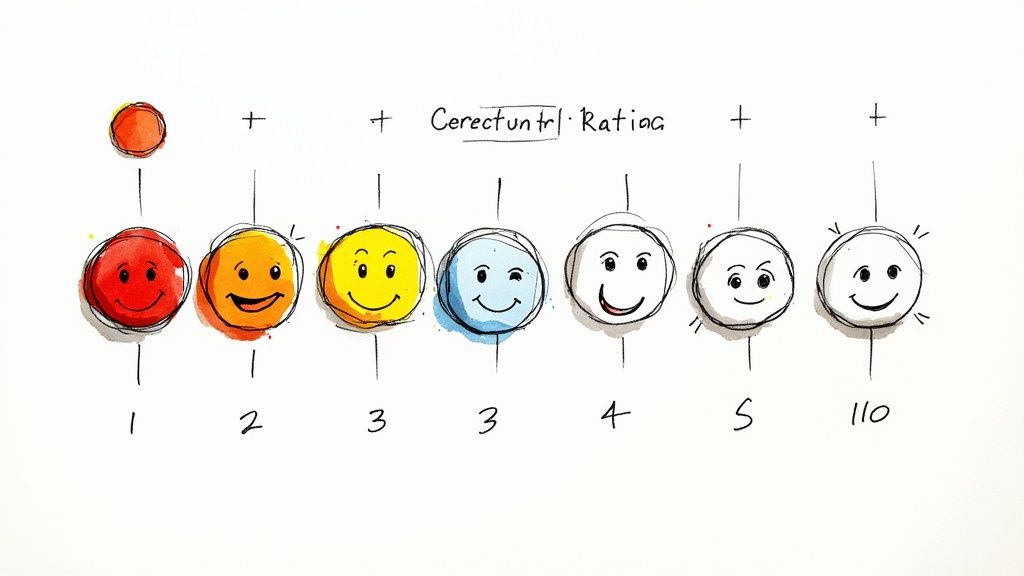AI Chatbots for Customer Service: The Complete Guide
Understanding the Chat Bot Revolution

Chat bot support is quickly becoming essential for modern business communication. The numbers tell a compelling story - the global chatbot market, currently at $15.57 billion, is set to reach$ 46.64 billion by 2029. This remarkable growth shows how businesses are embracing chat bots as a practical solution for customer service. For companies looking to stay competitive, understanding and implementing chat bot technology is becoming a necessity rather than just an option.
Why Chat Bots Are Transforming Customer Service
The business case for chat bots is clear. Companies can save up to $11 billion and recover approximately 2.5 billion hours by using chat bot solutions. But the benefits go beyond cost savings - chat bots provide round-the-clock support, answering customer questions instantly at any time of day. This constant availability means customers get help right when they need it, leading to better experiences and stronger relationships. When customers receive quick, helpful responses, they're more likely to return and recommend the business to others.
The Impact on Customer Experience
The positive effects of chat bot support are backed by real data. According to studies, 80% of customers report good experiences when interacting with chat bots. This high satisfaction comes from several key factors. Chat bots respond three times faster than human agents, leading to a 24% increase in support satisfaction scores. They also follow service guidelines consistently, giving every customer the same reliable experience. These quick responses and consistent service help build trust between businesses and their customers.
Key Benefits of Chat Bot Support
Here are the main advantages that chat bot support brings to businesses:
- Enhanced Efficiency: By handling routine questions, chat bots let human agents focus on complex issues
- Improved Accessibility: Support is available 24/7, helping customers whenever they need it
- Cost Reduction: Less manual work and lower staffing needs lead to significant savings
- Increased Customer Satisfaction: Quick responses and effective problem-solving make customers happier
- Scalability: Chat bots can manage many conversations at once as demand grows
These concrete benefits explain why more businesses see chat bot support as an essential part of their customer service approach. For companies that want to provide better service while managing costs, adding chat bots in a thoughtful way is becoming increasingly important.
Why Customers Are Embracing Automated Support
The shift towards chat bot support isn't just about following trends - it reflects fundamental changes in how people want to interact with businesses. Recent data shows that 62% of customers actively choose chatbots over human agents for support needs. Let's explore the key reasons behind this growing preference.
The Need for Speed and 24/7 Availability
Modern consumers expect quick answers at any hour of the day or night. Picture this: you're making an important online purchase at 2 AM and have a question about shipping. A chatbot can help you instantly, while waiting for a human agent could mean hours of delay. This constant availability is especially valuable for companies serving customers across time zones. The numbers back this up - chatbots respond three times faster than human agents on average, leading to a 24% boost in customer satisfaction scores.
Consistency and Reliability: Removing the Human Element (Sometimes)
One major advantage of chatbots is their reliability. Unlike human agents who might have different skill levels or be affected by mood and fatigue, chatbots deliver the same quality of service every time. They follow set guidelines precisely, ensuring each customer gets identical treatment. This steady, predictable service helps build customer confidence in the brand.
Empowering Customers Through Self-Service
Many customers prefer to solve straightforward problems on their own when possible. Chatbots give them this independence - whether they need to check order status (which 71% of people prefer handling through chatbots), reset passwords, or find quick answers to common questions. This ability to get things done without waiting for human assistance gives customers a sense of control and efficiency. For more insights, check out: How to master AI chat bot customer service.
Meeting Evolving Customer Expectations
The demand for fast, efficient support continues to grow stronger. In fact, 69% of customers say they would use a chatbot if it meant getting their issue resolved more quickly. This shows how chatbots are becoming essential, not optional, for meeting modern customer service standards. As AI technology improves, chatbots will play an even bigger role in creating great customer experiences.
Building a Customer-Centric Chat Bot Support Strategy

More customers now prefer automated support options when interacting with businesses. This shift opens up new possibilities to create chat bot systems that both meet customer needs and benefit companies. The key is focusing on making the experience smooth and positive through careful planning and implementation.
Designing Conversational Flows That Feel Natural
The success of chat bot support depends on creating natural-feeling conversations. Rather than stiff, mechanical exchanges, the goal is to mirror genuine human interaction. This means understanding what customers are trying to accomplish and responding in a way that's both useful and engaging. Simple touches like personalized greetings and friendly language can dramatically improve how people experience the interaction and help build trust with your brand.
Creating Intelligent Escalation Paths
While chat bots handle routine questions well, some situations need human expertise. Having smart escalation paths ensures complex issues get smoothly handed off to human agents. Your chat bot should recognize scenarios that require personal attention - for example, when a customer shows signs of frustration or the bot can't understand their request after several tries. A clear escalation process helps customers get the right level of support without unnecessary delays or confusion.
Combining Automated and Human Assistance
The most effective chat bot strategies blend automated and human support. Chat bots efficiently manage common tasks, which frees up human agents to focus on more challenging issues. Picture it like a coordinated support team - the chat bot handles initial questions and information gathering, while human agents provide expert help when needed. This balanced approach makes the best use of resources while ensuring every customer gets prompt, effective assistance.
Measuring Success and Continuous Improvement
Developing customer-focused chat bot support is an ongoing process. Tracking key metrics like satisfaction scores, resolution rates, and escalation frequency shows how well your bot performs. Reviewing this data helps identify areas to improve and expand your chat bot's capabilities. Sitebot provides detailed analytics to understand customer interactions and optimize performance. Regular assessment and data-driven adjustments keep your chat bot support system aligned with customer needs and expectations.
Maximizing ROI Through Intelligent Implementation
Getting real business value from chatbot support requires more than just installing the technology. Success comes from careful planning, smart execution, and continuous refinement based on results. Let's explore the key elements that drive strong returns on your chatbot investment.
Defining Clear Objectives and KPIs
Start by identifying exactly what you want your chatbot to achieve. Do you need to cut support costs? Speed up response times? Boost customer satisfaction? Your goals shape both implementation and measurement. For instance, if cost savings is the priority, track metrics like the number of support tickets the chatbot handles independently. If you're focused on customer experience, measure satisfaction scores and successful resolution rates. This targeted approach ensures your chatbot strategy delivers the specific outcomes your business needs.
Optimizing Resource Allocation and Workflow
Smart implementation means using resources wisely. Chatbots excel at handling common questions and basic requests, which frees up your human agents to tackle complex issues requiring judgment and expertise. Think of it as building a tag-team approach - chatbots handle initial contact and routine matters while agents step in for situations needing a personal touch. This division of labor helps control staffing costs while ensuring customers get the right level of support.
Leveraging Data-Driven Insights for Continuous Improvement
Regular analysis of chatbot interactions reveals opportunities to enhance performance. Pay attention to where conversations break down or customers ask for human help. Look for common questions the chatbot struggles with. Use these insights to expand the chatbot's knowledge, improve conversation flows, and refine when to involve agents. This ongoing optimization keeps your chatbot aligned with customer needs and consistently valuable. For more on measuring chatbot effectiveness, check out: Unlock the Secrets of Your Chatbot's Success with These Analytics Tricks.
Calculating the Real Impact on Your Bottom Line
ROI goes beyond direct cost savings. Consider the total business impact, including higher customer satisfaction, increased sales, and stronger brand loyalty. While the projected $11 billion in chatbot-driven cost savings is significant, the true value often lies in improved customer relationships and experiences. Looking at these broader benefits gives you a complete picture of how chatbot support strengthens your business. This comprehensive view helps justify continued investment and guides long-term strategy. The goal isn't just automation - it's building more efficient, customer-focused support that drives real business results.
How AI Improves Chat Bot Performance

AI technology helps chat bots go beyond basic scripted conversations to provide smart, personalized support. By understanding context and adapting to each customer, AI-powered chat bots can engage in more natural conversations while efficiently resolving issues. The result is better customer experiences and more effective support.
Making Chat Bots Smarter with Machine Learning and NLP
Two key technologies make modern chat bots effective: Machine Learning (ML) and Natural Language Processing (NLP). NLP helps bots understand how people actually talk - including casual language, typos, and different ways of asking the same thing. For example, whether a customer asks about "shipping info" or "when will my order arrive?", the bot can understand they want delivery details. ML allows bots to keep improving by learning from every interaction. The more conversations they have, the better they become at providing helpful, accurate responses.
Reading Customer Signals and Making Support Personal
Smart chat bots can spot patterns in customer behavior to offer help at just the right time. By looking at things like browsing history and past purchases, bots can suggest relevant products or information before customers even ask. They also remember details about each customer to make conversations feel more personal - using their name, recalling previous orders, and recommending items based on their preferences. This personal touch helps build stronger customer relationships and keeps people coming back.
Getting Better Results Through Smarter Understanding
AI makes chat bots more accurate in two important ways. First, they continuously learn from every interaction to improve their responses over time. Second, they can figure out what customers really want, even when questions are phrased differently. For instance, if someone asks about "refunds" or "sending items back," the bot knows they need help with returns. This combination of ongoing learning and smart comprehension means AI chat bots can solve problems faster and more accurately. When bots handle routine questions efficiently, human agents can focus on more complex customer needs.
Picking the Right AI Features for Your Needs
When adding AI to your chat bot, focus on what makes sense for your business and customers. Not every company needs advanced features - some may only need basic language understanding, while others benefit from sophisticated recommendation systems. Choose AI capabilities that fit your budget and actually improve your customer experience. This targeted approach ensures you invest wisely while meeting customer expectations. The next section will explore how to future-proof your chat bot as technology continues to advance.
Future-Proofing Your Chat Bot Strategy

Chat bot technology keeps evolving at a rapid pace. Businesses need to stay ahead by understanding where this technology is headed and adapting their approach accordingly. Taking proactive steps now helps ensure your chat bot continues meeting customer needs effectively as capabilities advance.
Emerging Trends in Chat Bot Support
Several key developments are reshaping how chat bots serve customers. Being aware of these trends helps you incorporate them into your strategy at the right time.
- Deep Personalization: Chat bots now deliver truly individualized experiences by analyzing customer data in real-time. For instance, a bot can recommend products based on past purchases, current browsing behavior, and even contextual factors like location or weather. This creates interactions that feel natural and personalized.
- Unified Channel Experience: Creating smooth handoffs between channels is essential. When a customer starts chatting on your website, that conversation history should carry over seamlessly to email, social media, or in-person interactions. This builds a more connected customer journey.
- Smarter AI Systems: Artificial intelligence capabilities keep improving, helping chat bots better understand complex language, predict customer needs, and solve problems proactively. This means bots can spot potential issues and offer solutions before customers need to ask.
- Understanding Emotions: The next generation of chat bots will recognize tone and sentiment to adjust their communication style appropriately. By responding with empathy and emotional awareness, these bots create more natural, engaging conversations.
Preparing for the Future of Chat Bot Support
Taking these steps helps your chat bot strategy stay current and effective:
- Keep Learning: AI technology changes quickly. Stay informed about new developments and test different features to find what works best for your customers.
- Protect Customer Data: As chat bots handle more sensitive information, strong security measures become crucial. Invest in protecting customer data to maintain their trust.
- Balance Automation and Human Touch: While chat bots handle routine tasks well, human agents excel at complex problem-solving. Create clear handoff points between bots and staff members.
- Choose Adaptable Tools: Select chat bot platforms that can easily incorporate new features and connect with your other systems. This helps you stay current without major system overhauls.
Evaluating New Chat Bot Technologies
Consider these key questions when looking at new chat bot tools:
| Question | Importance |
|---|---|
| Does it improve customer experience? | Will customers find interactions more helpful and personalized? |
| Is it scalable? | Can it handle growing customer volumes effectively? |
| Is it secure? | Are there strong protections for customer data? |
| Does it integrate with existing systems? | Will it work smoothly with your current tools and platforms? |
Careful evaluation helps you choose technologies that align with your goals. You might be interested in: Revolutionizing customer service: Creating your own GPT chatbot.
By staying flexible and embracing helpful new features, you can build a chat bot system that consistently delivers great customer experiences and helps grow your business.
Ready to create a powerful AI chatbot customized for your needs? Get started with Sitebot now!


